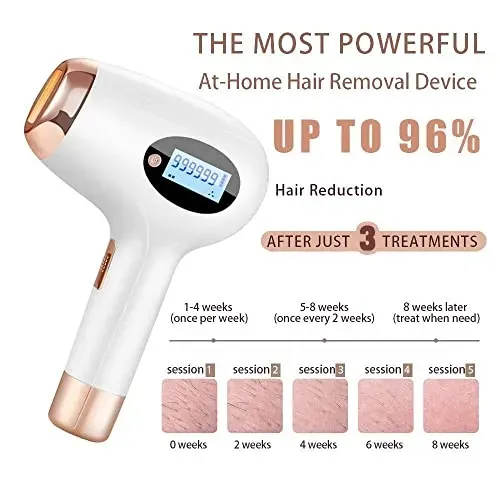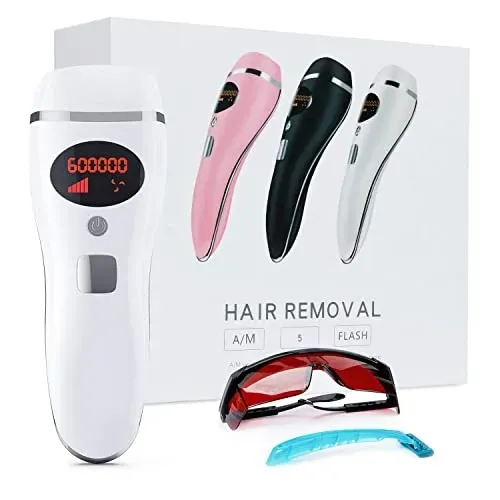Table of Contents
Tired of the endless cycle of shaving, waxing, and plucking? You're not alone. Dealing with unwanted hair can feel like a part-time job, a constant battle against stubble and ingrown hairs. It makes sense that folks start looking for longer-term solutions that don't involve a trip to the salon every few weeks. At-home laser hair removal devices promise a way out, offering the potential for smoother skin from the comfort of your bathroom.
What to Look for in AtHome Laser Hair Removal Devices

What to Look for in AtHome Laser Hair Removal Devices
Alright, so you're thinking about diving into the world of at-home hair removal devices? It's a smart move if you're tired of the endless chore of hair removal. But before you just grab the first sleek-looking gadget you see, there are a few key things you absolutely need to consider. Think of it like buying a car – you wouldn't just pick one based on the color, right? You need to look under the hood. The big stuff includes understanding the technology, making sure it's safe for your specific skin type and hair color, and figuring out if the device is actually built to last and deliver consistent results over time. It’s not just about getting rid of hair today; it's about reducing it long-term.
One of the first things to wrap your head around is the type of technology the device uses. Most at-home devices fall into two main categories: IPL (Intense Pulsed Light) and actual laser. They both work by targeting the pigment in your hair follicle to damage it and slow down growth, but they do it differently. IPL uses a broad spectrum of light, while laser uses a single, focused beam. This difference matters a lot when it comes to effectiveness and safety, especially depending on your skin tone. You also need to check for FDA clearance. It doesn't mean it's a miracle cure, but it does mean the device has gone through some level of safety review.
- FDA Clearance: Does it have it? This is a baseline safety check.
- Technology Type: Is it IPL or true laser? Understand the difference.
- Skin Tone and Hair Color Compatibility: This is critical for safety and effectiveness.
- Energy Levels and Settings: Can you adjust the intensity?
- Treatment Area Size: How big is the window? This affects how long treatments take.
- Corded or Cordless: Convenience factor.
- Replacement Cartridges: Is there an ongoing cost?
- Reviews and Reputation: What are other users saying?
Beyond the tech, think about the practical side. How big is the treatment window? A tiny window means endless sessions on larger areas like legs. How many flashes does the device offer? Some have a limited lifespan before you need to buy expensive replacement cartridges. Also, consider the ergonomics – is it comfortable to hold and maneuver, especially for those awkward spots? And don't forget about pain tolerance. While often less intense than professional treatments, there can still be a snapping or warming sensation. Some devices have cooling features to help with this.
Understanding the Tech: IPL vs. Laser Devices

Understanding the Tech: IPL vs. Laser Devices
What's the Deal with IPL?
let's talk about the engine under the hood. Most at-home hair removal gadgets you see lining the shelves or popping up in ads? They're usually using IPL technology, which stands for Intense Pulsed Light. Think of IPL like a camera flash, but way more intense. It blasts a broad spectrum of light wavelengths across a wider area of skin. This light gets absorbed by the pigment (melanin) in your hair. When the melanin absorbs the light, it heats up, ideally damaging the hair follicle enough to slow down future growth. Because it uses multiple wavelengths, IPL is generally considered less focused and often requires more sessions compared to clinical lasers. It's also typically safer for a wider range of skin tones compared to some older laser tech, but still has limitations, especially on darker skin or very light hair.
How True Laser Devices are Different
Now, true laser hair removal devices are a different beast. Instead of a broad flash of light, they emit a single, focused beam of light at a very specific wavelength. This targeted approach means the energy is concentrated directly on the melanin in the hair follicle, often making it more powerful and potentially more effective in fewer sessions than IPL for suitable candidates. These are closer to the machines you might see in a professional clinic, though typically at lower energy levels for safety at home. Because they are so targeted, they can be more precise but also might cover smaller areas at a time. It's like the difference between using a floodlight (IPL) and a laser pointer (true laser) – both use light, but the way they deliver it is fundamentally different, impacting who they work best for and how they perform.
Feature | IPL (Intense Pulsed Light) | True Laser |
|---|---|---|
Light Type | Broad spectrum of wavelengths | Single, focused wavelength |
Targeting | Less precise, covers wider area | Highly precise, targets specific follicle |
Energy Level (At Home) | Generally lower | Can be higher per pulse, but overall energy limited for safety |
Treatment Area | Usually larger window | Often smaller spot size |
Sessions Needed | Typically requires more sessions | May require fewer sessions for results |
Skin/Hair Suitability | Wider range than older lasers, but still limited (best on light skin/dark hair) | More targeted, effectiveness varies by laser type; traditionally best on light skin/dark hair |
Safety and Skin Tone: Picking the Right AtHome Laser Hair Removal Device

Safety and Skin Tone: Picking the Right AtHome Laser Hair Removal Device
Why Skin Tone and Hair Color Are the Deciding Factors
let's get serious for a second. This isn't just about getting smooth legs; it's about doing it without burning yourself. The absolute most critical factor when choosing an at-home hair removal device is your skin tone and hair color. These devices work by targeting the pigment (melanin) in your hair follicle. The light energy gets absorbed by this pigment, turns into heat, and zaps the follicle. Simple enough, right? Not quite.
Your skin also contains melanin. If your skin has a lot of melanin (i.e., you have a darker skin tone), it will absorb the light energy intended for the hair follicle. When your skin absorbs too much energy, you risk burns, blistering, hyperpigmentation (dark spots), or hypopigmentation (light spots). It's a delicate balance, and using a device not designed for your specific skin type is like playing with fire. Most at-home IPL devices, for instance, are designed for lighter skin tones (think Fitzpatrick Scale types I to IV) and dark hair. Very light hair (blonde, red, gray) often doesn't have enough pigment for the light to target effectively, regardless of skin tone. So, before you even look at features or price, look at the compatibility chart.
The Real Risks of Getting it Wrong
Ignore the skin tone warnings, and you're asking for trouble. We've all seen those online horror stories – nasty burns, permanent discoloration, scarring. It happens when the device dumps too much energy into the skin instead of the hair. It's not just uncomfortable; it can leave lasting marks. Some devices have built-in skin tone sensors that prevent them from firing on darker skin, which is a crucial safety feature. Others rely entirely on you to read the manual and follow the guidelines. Trust me, reading the manual is far less painful than dealing with a second-degree burn.
Beyond burns, there's the frustration of spending money on a device that simply won't work for you. If your hair is too light or your skin is too dark for a particular model, you'll get zero results, no matter how many times you use it. That's a waste of money and time. It’s why checking the device’s stated compatibility with the Fitzpatrick skin tone scale is non-negotiable. Don't guess. Know your skin type and buy accordingly.
- Fitzpatrick Skin Tone Scale: Know your type (I-VI).
- Device Compatibility Chart: Check the device's specific recommendations.
- Skin Tone Sensor: Look for this safety feature.
- Hair Color: Confirm the device works on your hair pigment.
- Patch Testing: Always perform a test patch before a full treatment.
Finding a Device That Matches Your Melanin Levels
So, how do you find a match? First, determine your Fitzpatrick skin type. There are charts online, but generally, Type I is very pale, burns easily, never tans; Type VI is very dark, never burns. Most at-home devices are safest and most effective for Type I to IV with dark hair. If you have a darker skin tone (Type V or VI), your options are significantly limited. Some newer devices use different wavelengths or pulse patterns designed to be safer for darker skin, but they are less common and often more expensive. Research specific technologies if you have darker skin.
Look for devices that explicitly state their compatible skin tones and hair colors. Don't rely on vague claims. A good device will have a clear chart in the product description or manual. Some might even have apps that help you determine your skin tone and set appropriate energy levels. Prioritizing safety features like a skin tone sensor isn't being overly cautious; it's being smart. When evaluating potential candidates for a "consumer reports best laser hair removal" type of list, suitability for different users based on these fundamental factors is paramount.
Comparing Devices: What Might Make a Consumer Reports Best Laser Hair Removal List

Comparing Devices: What Might Make a Consumer Reports Best Laser Hair Removal List
Performance Metrics That Matter
so you've got the basic tech down (IPL vs. Laser) and you know the absolute necessity of matching skin tone and hair color. Now, how do you figure out which device is actually *good* at doing the job? This is where performance comes in, the stuff that would land a device on a "consumer reports best laser hair removal" kind of list. It’s not just about flashing lights; it’s about effectiveness over time. Does it significantly reduce hair growth after the recommended treatment period? Are those results lasting, or does the hair sprout back immediately? You need to look at things like the energy output per pulse – higher energy can mean more effective treatment, but only if it's safe for your skin type. Consistency is key too. A good device delivers the same energy level every time, across the entire treatment window, not weaker pulses around the edges.
Think about the speed of treatment. Some devices have rapid firing modes, letting you zip over larger areas like legs quickly. Others require a longer pause between flashes. If you're planning to treat big areas, a slow device will feel like watching paint dry. Also, consider the number of flashes the bulb or cartridge is rated for. A device with a low flash count means you'll be buying replacements sooner rather than later, adding to the overall cost. A high flash count, often in the hundreds of thousands, means the device itself is likely to last a good long while before you need to worry about refills.
Beyond the Flash: Safety and Usability
Effectiveness is important, but not at the expense of safety or your sanity. Any device potentially making a "consumer reports best laser hair removal" roundup would be scrutinized for its safety features. We're talking about reliable skin tone sensors that actually prevent firing on unsuitable skin, temperature regulators that keep the device from overheating (and potentially burning you), and clear instructions. Usability is huge too. Is the device comfortable to hold for a 20-minute session? Is the button placement intuitive? Can you easily see the treatment window and position it correctly? Nobody wants a device that feels like a brick or requires a contortionist act to use on your own legs.
Durability is another factor often overlooked. These devices aren't cheap. You want something that feels well-built, not like it's going to fall apart after a few uses. Are the materials sturdy? Does the cord feel robust (if it's corded)? What's the warranty like? A solid warranty suggests the manufacturer stands behind their product. A flimsy device with a short warranty might save you a few bucks upfront, but it could cost you more in the long run if it breaks.
- Reliable Skin Tone Sensor: Prevents unsafe use.
- Ergonomic Design: Comfortable to hold and use.
- Treatment Speed: How quickly can you cover an area?
- Number of Flashes: Longevity of the device/cartridge.
- Build Quality: Does it feel durable?
- Warranty: Manufacturer confidence and your protection.
Value, Support, and Real-World Results
Finally, let's talk brass tacks: value for money and the overall experience. The price tag is just the starting point. You need to factor in the cost of replacement cartridges (if any) over the device's lifespan. Compare that to the cost of salon treatments. For many, even an expensive at-home device from hairawaybylaser.com can end up being significantly cheaper over a year or two of consistent use. But value isn't just about cost; it's about the results you get for that price. Are people actually achieving significant hair reduction, or just a temporary slowdown?
Customer support is another piece of the puzzle. If something goes wrong, or you have questions about usage, is there a responsive support team? Check reviews for mentions of customer service experiences. Ultimately, what truly matters is the real-world performance for everyday users. Does the device consistently get positive feedback from people with similar skin and hair types? Are the results worth the time and effort? Looking at aggregated user experiences, much like a comprehensive "consumer reports best laser hair removal" analysis would do, gives you a much clearer picture than just reading the manufacturer's claims.
Managing Expectations: Results, Time, and Cost of AtHome Laser Hair Removal

Managing Expectations: Results, Time, and Cost of AtHome Laser Hair Removal
It's Hair Reduction, Not a Miracle Eraser
Alright, let's pump the brakes on the fantasy of one quick zap and permanent baby-smooth skin forever. That’s not how this works, even with devices that might get rave reviews or show up on lists like a hypothetical "consumer reports best laser hair removal." What you're buying into is hair *reduction*, not necessarily permanent hair *removal*. The goal is to significantly decrease the amount of hair that grows back, make it finer, and slow down its regrowth. Think of it as getting your lawn under control, not paving over the whole yard.
Achieving noticeable results takes time and commitment. You're not going to see a huge difference after just one session. Most manufacturers recommend a series of initial treatments, often weekly or bi-weekly for the first month or two, followed by maintenance sessions as needed. This can mean anywhere from 4 to 12 initial sessions, and then potentially monthly or even less frequent touch-ups down the line. If you're expecting instant gratification, you'll be disappointed. It's a marathon, not a sprint, requiring patience and sticking to a schedule even when you don't feel like it.
Counting Sessions and Counting Pennies
Beyond the time investment for each session (which can range from minutes for small areas to an hour or more for larger ones), there's the overall cost to consider. The initial purchase price of an at-home device can be a significant chunk of change, anywhere from a couple hundred to well over a thousand dollars. But that might not be the end of it. Some devices use cartridges with a limited number of flashes, meaning you'll need to buy replacements periodically. Factor that into your budget.
Compared to professional laser hair removal treatments at a clinic, at-home devices are generally much more affordable in the long run, especially if you're treating multiple areas. A single professional session can cost as much as a decent at-home device. However, professional treatments are typically more powerful and might achieve results faster, though they still require multiple sessions. It's a trade-off between cost, convenience, power, and the time you're willing to invest yourself. Don't just look at the sticker price; calculate the potential cost over a year or two, including any cartridge refills, to get a real sense of the investment.
- Expect hair *reduction*, not necessarily permanent removal.
- Results require multiple sessions (often 4-12 initial treatments).
- Maintenance sessions are usually needed over time.
- Initial device cost varies widely ($200 - $1000+).
- Factor in potential cost of replacement cartridges.
- Overall cost is typically lower than professional treatments, but requires your time and effort.
- Patience and consistency are non-negotiable for seeing results.
The Final Word on At-Home Hair Removal
Navigating the world of at-home hair removal devices isn't as simple as grabbing the first gadget you see. While a definitive "consumer reports best laser hair removal" list might be elusive, the principles behind what makes a device effective and safe remain the same. It boils down to understanding the technology, knowing your skin type, and having realistic expectations about the process. You're not getting instant, permanent results like a magic wand, despite what some marketing might imply. It takes time, consistency, and patience. Do your homework, consider the factors we've discussed, and remember that smooth skin is a journey, not a one-time purchase.
